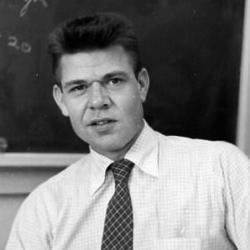Nationality American Name Ralph James | Fields Chemistry | |
 | ||
Born September 23, 1920Salt Lake City, Utah ( 1920-09-23 ) Awards Guggenheim Fellowship for Natural Sciences, US & Canada | ||
Ralph Arthur James (23 September 1920 in Salt Lake City, Utah – 24 February 1973 in Alamo, California) was a chemist at the University of Chicago who co-discovered the elements curium (1944) and americium (1944–1945). Later he worked at UCLA and at the Lawrence Livermore laboratory in California.
Contents
He also worked on niobium and nuclear spectroscopy.
Scientific career
James was part of the Laboratory of Metallurgy, University of Chicago, the team headed by Glenn T. Seaborg. The laboratory had large amounts of plutonium (discovered in 1940–41) that was being produced in Hanford Site to make nuclear weapons. This allowed them to discover two new elements, although the difficulties for study and isolation were great.
In 1944, Seaborg decided to extend the search to heavier elements, and notified chemists Ralph A. James and Leon O. Morgan that irradiasen plutonium and they sent the samples to Chicago for Albert Ghiorso to analyze. By identifying characteristics of emitted alpha particles they found the new elements.
Discovery of curium
Curium (atomic number 96) was discovered in 1944 by Glenn T. Seaborg, Ralph A. James and Albert Ghiorso during World War II in the Chicago Metallurgical Laboratory, as part of the Manhattan Project, by bombing plutonium with helium ions. It was named in honor of Pierre Curie and Marie Sklodowska Curie.
Discovery of americium
Similarly, americium (atomic number 95) was discovered in 1944–45 by Glenn T. Seaborg, Ralph A. James, Leon O. Morgan and Albert Ghiorso, working in the Manhattan Project. By bombing plutonium neutrons in the 60-inch cyclotron at the University of California, Berkeley. It was named after the continents of America, and because it is a homologous element of europium (atomic number 63), positioned right above it.
